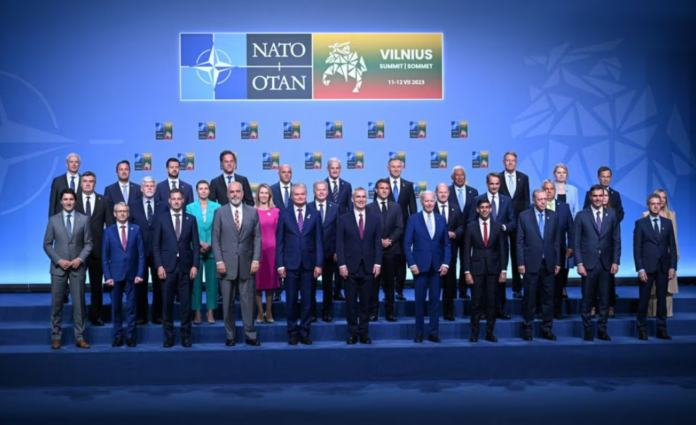Meeting in the Lithuanian capital Vilnius, NATO leaders promised to invite Ukraine to join the bloc “when allies agree and conditions are met” with an accelerated accession process. They also extended new aid to President Volodymyr Zelenskyy’s government for the long term and established structures for closer coordination, according to Bloomberg.
NATO advanced its plans for enlargement in response to Russian aggression, firming up the prospects for Ukraine’s future membership and securing a breakthrough deal with Sweden that will complete its expansion northwards.
“What we have agreed is a very substantive package that helps to move Ukraine closer to NATO,” Secretary General Jens Stoltenberg said at a press conference to conclude the first day of talks. “There’s never been a stronger message from NATO at any time.”
That message applied also for the alliance’s Nordic expansion. Finnish President Sauli Niinisto attended the summit as a full member for the first time and he was joined by Swedish Prime Minister Ulf Kristersson, who helped persuade Turkey to lift its objections to his own country’s application on the eve of the talks. Adding Finland and Sweden to the alliance vastly increases NATO’s ability to support the three Baltic members that could have been easily cut off from the rest of the alliance in a conflict.
In another show of support for Ukraine on Wednesday, the Group of Seven nations are separately expected to offer Ukraine additional security commitments on the sidelines of the summit with the aim of deterring Russia from attacking again in the future.
The developments build out a new security framework that emerged last year in response to Russian President Vladimir Putin’s invasion of Ukraine. With Finland and Sweden abandoning decades of neutrality and NATO allies deepening their coordination with Kyiv after shipping billions of dollars worth of tanks, missiles and other weaponry, Putin’s idea of a buffer zone between Russia and the West has been consigned to history.
Fifteen years ago, the alliance’s pledge that Ukraine would one day join proved insufficient to prevent the steady ramp up of Russian hostility that led to last year’s full-scale invasion. Allies have in recent months been grappling with how to move beyond that 2008 summit statement.
Some countries were worried that they would limit their room for maneuver in future negotiations with the Kremlin if the pledge is too concrete, according to an official. Others were concerned that the eventual statement wasn’t sufficiently resolute and risked repeating the mistakes of the previous generation.
Ahead of the agreement, Zelenskyy, who will meet with President Joe Biden on Wednesday, criticized the alliance for refusing to give him a clear timeline for membership in a statement posted on Twitter as he was traveling to the meeting.
“This looks like there’s neither readiness to invite Ukraine to NATO nor make it a member of the alliance,” he said, adding that such an “unprecedented and absurd” outcome would leave his country more vulnerable to Russian pressure in any potential future negotiations.
Estonian Prime Minister Kaja Kallas said there was frustration from the Ukrainian side over the wording of the final NATO statement, which came short of offering a clear timetable for Kyiv’s accession to the alliance.
“We were not saying Ukraine should join NATO while the war is ongoing, everyone understands that’s not possible,” Kallas told reporters on Wednesday. “But there are words we can use.”
Russia’s war effectively cuts off NATO membership for Ukraine for now, since extending the bloc’s collective defense commitments to Kyiv would bring the US and its allies into direct conflict with Russia, and that’s a situation that western leaders aren’t prepared to countenance.
The Ukrainian president later told a crowd of thousands gathered in the center of the Lithuanian capital that Ukraine will make NATO stronger and the alliance will give his country security.
Tuesday’s agreement means that Ukraine will no longer need to go through a MAP before joining the alliance. Instead, Kyiv will face regular reviews on its progress on tackling corruption and other reforms.
NATO allies individually are due to commit to equipping Ukraine with modern weapons in the long-term, as well as providing training, sharing intelligence and supporting the development of the country’s defense industry. Each nation will provide different commitments, and other countries can join the arrangements, with specifics to be negotiated in the future.


